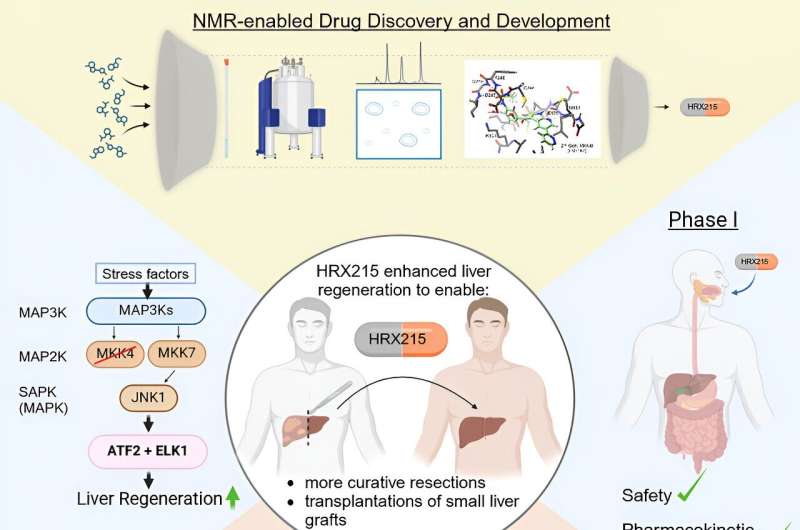This article has been reviewed according to Science X's editorial process and policies. Editors have highlighted the following attributes while ensuring the content's credibility:
fact-checked
peer-reviewed publication
proofread
Next milestone in the treatment of liver tumors and acute and chronic liver diseases

The results of a Tübingen-led study raise hope that a newly developed drug could herald a new era in oncological liver surgery and liver transplantation. The drug could even have the potential to significantly improve the treatment of acute and chronic liver diseases.
The drug candidate HRX-215 is a so-called MKK4 inhibitor, i.e. the administered drug inhibits the MKK4 protein found in liver cells and thus leads to an increase in the regeneration of liver cells. The study results have now been published in the journal Cell.
The preclinical and phase I studies were made possible by a collaboration led by Prof. Dr. Lars Zender, Medical Director of the Department of Medical Oncology and Pneumology at Tübingen University Hospital and Tübingen scientists, the Tübingen start-up HepaRegeniX and researchers from the Mayo Clinic (U.S.).
Preclinical studies in animal models have shown that the increased liver regeneration caused by HRX-215 could allow liver surgery that was previously not possible. For example, in cases of advanced liver tumors, it has not been possible to remove all of the diseased tissue because doing so would cause the remaining liver to fail.
Even individuals with advanced liver tumors may now be able to have them totally removed, thanks to HRX-215's potential to boost liver regeneration rapidly. Furthermore, the active substance would be able to provide more people with a life-saving liver transplant. A phase I study in 48 healthy volunteers showed excellent safety and tolerability of the drug.
Liver diseases as a growing health problem
Liver diseases are a global health problem and are responsible for more than two million deaths per year. The number of deaths has risen by 50 percent in recent decades and is expected to double in the next 20 years. Although the liver is an organ that can regenerate itself, this property has its limits.
Particularly in chronic and acute liver diseases or after the surgical removal of a large part of the organ, the liver cells can no longer regenerate sufficiently, resulting in often fatal liver failure. Liver transplantation remains the last option for patients with end-stage liver disease; however, only ten percent of affected patients are able to receive a life-saving liver transplant due to organ scarcity.
Clinical results give reason for hope
As there were previously no drugs that could increase the regeneration of a damaged liver, the results published in Cell with the new drug HRX-215 are a milestone.
"The positive results in terms of safety and tolerability confirm our intention to offer soon a drug that has the potential to revolutionize the treatment of acute liver diseases," says Dr. Wolfgang Albrecht, Managing Director of the Tübingen-based start-up company HepaRegeniX. The current results and the spin-off of HepaRegeniX were largely made possible by a groundbreaking discovery of Lars Zender and his laboratory in 2013.
"By inhibiting the kinase MKK4, the self-healing function of a damaged liver can be triggered," says first author Stefan Zwirner, summarizing the findings.
Possible solution to organ donation shortage?
"HRX-215 would not only be an urgently needed treatment option in the surgical removal of liver tumors, but would also be able to help overcome the major problem of organ shortage in the field of liver transplantation," Prof. Zender points out the possible applications. Living transplants from the smaller left part of a healthy donor's liver would be a solution, as removal poses little health risk for healthy donors.
However, this part of the liver is often too small to take over the function of the liver that was removed from the recipient. "Due to the rapid enhancement of liver regeneration mediated by HRX-215, we assume that HRX-215 treatment would enable the safe transplantation of small left liver lobes in normal size adults," Prof. Zender continues. However, clinical studies will have to show this in the future.
More information: Stefan Zwirner et al, First-in-class MKK4 inhibitors enhance liver regeneration and prevent liver failure, Cell (2024). DOI: 10.1016/j.cell.2024.02.023




















